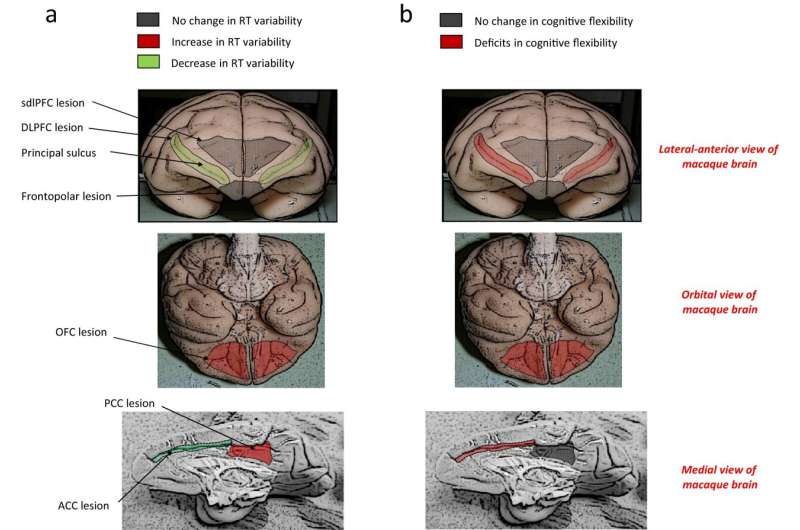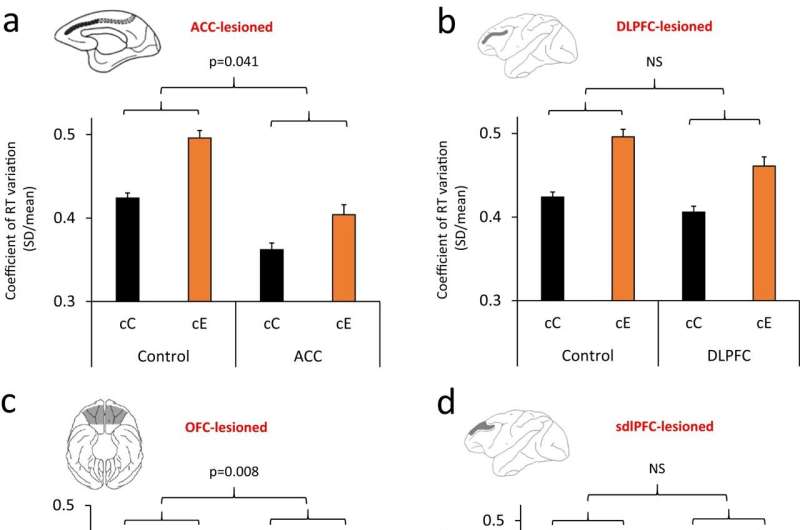This article has been reviewed according to Science X's editorial process and policies. Editors have highlighted the following attributes while ensuring the content's credibility:
fact-checked
peer-reviewed publication
trusted source
proofread
How different areas of the prefrontal cortex influence time variability in individual monkeys

Neuroscientists from RIKEN have discovered the effects that different areas in the prefrontal cortex of macaque monkeys have on the variability in the time it takes them to perform tasks involving quick decisions. This information could help to tailor rehabilitation for people with injuries to their prefrontal cortex.
We often need to perform tasks that require making fast judgment calls in rapid succession. The time it takes to do each individual task is fairly constant for a young person, but for an older person it can vary by quite a lot between tasks.
"Healthy, young people tend to have a consistently high performance when performing these tasks," explains Keiji Tanaka of the RIKEN Center for Brain Science. "But as you age, it becomes more inconsistent—sometimes you perform well and other times badly. This variability occurs over a short period of a few minutes."
This quality has important ramifications for everyday life. For example, it can be used to predict the mortality rate of elderly people from all causes. "It's also a key issue for society," says Tanaka. "We want employees to be consistent."
But the cause for the variability has not been studied very much. The prefrontal cortex—the brain region responsible for many of our higher cognitive functions—is thought to be involved. "It's a metric that degrades with aging but also with brain damage, especially to the prefrontal cortex," notes Tanaka. "But not much else is known beyond that."

To discover what effect different areas of the prefrontal cortex have on the variability, Tanaka and two co-workers have conducted experiments on 21 macaque monkeys. Their work is published in the journal Nature Communications.
They trained the monkeys to perform tasks that involved selecting a stimulus that has either the same color or the same shape as a target stimulus. To make things trickier for the monkeys, the researchers switched the rules (same color or same shape) midway.
The team then damaged, or lesioned, different areas of the prefrontal cortex and observed the effect it had on the monkeys' performance in the tests.
They found that the response time variability decreased on lesioning one area (anterior cingulate cortex), while it increased on lesioning another area (orbitofrontal cortex). Lesions in two other prefrontal areas (frontopolar cortex and mid-dorsolateral prefrontal cortex) had little effect on response time variability.
These findings provide valuable insights into how the various parts of the prefrontal cortex operate during decision making, Tanaka says.
More information: Farshad Alizadeh Mansouri et al, Mapping causal links between prefrontal cortical regions and intra-individual behavioral variability, Nature Communications (2024). DOI: 10.1038/s41467-023-44341-5




















